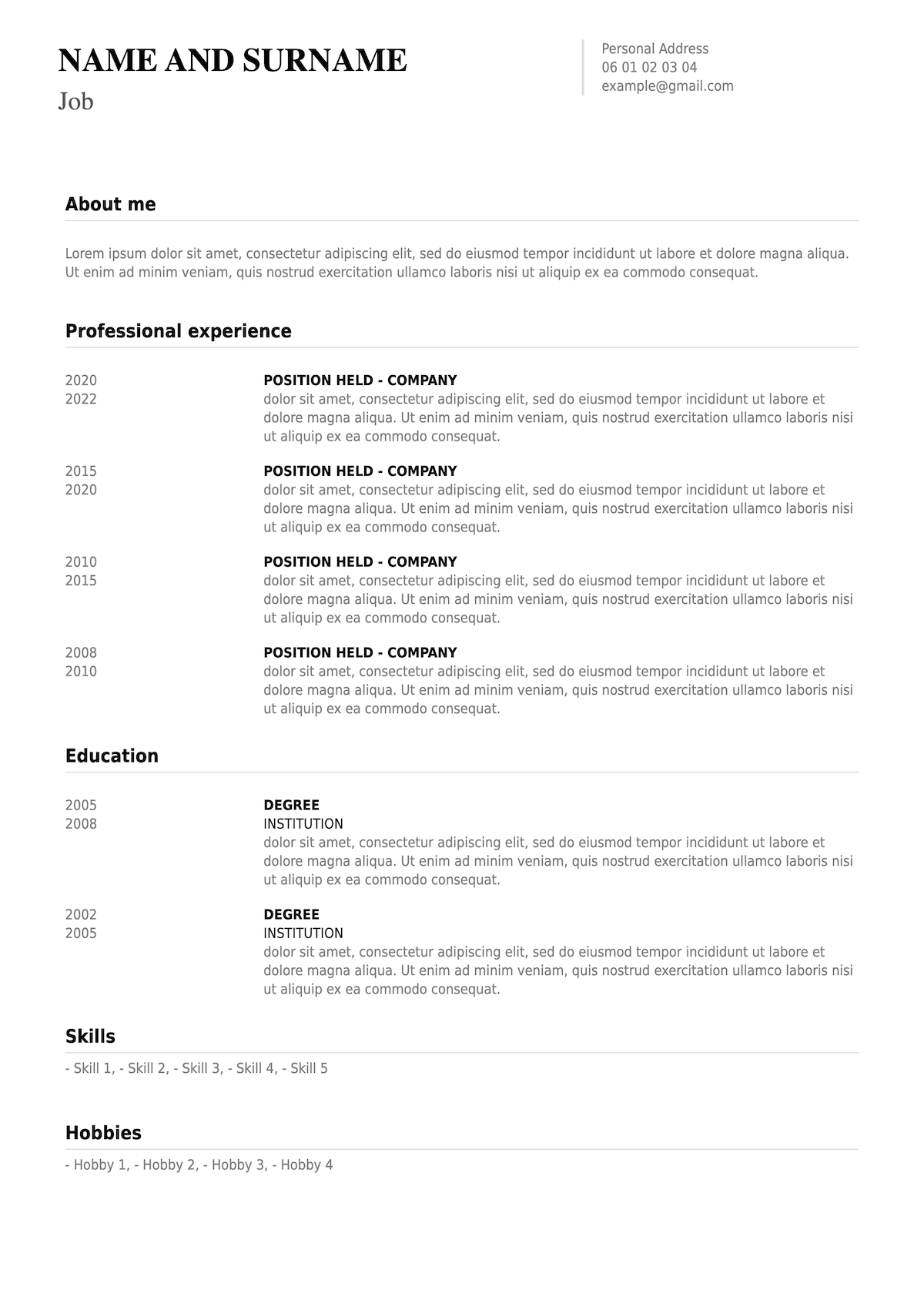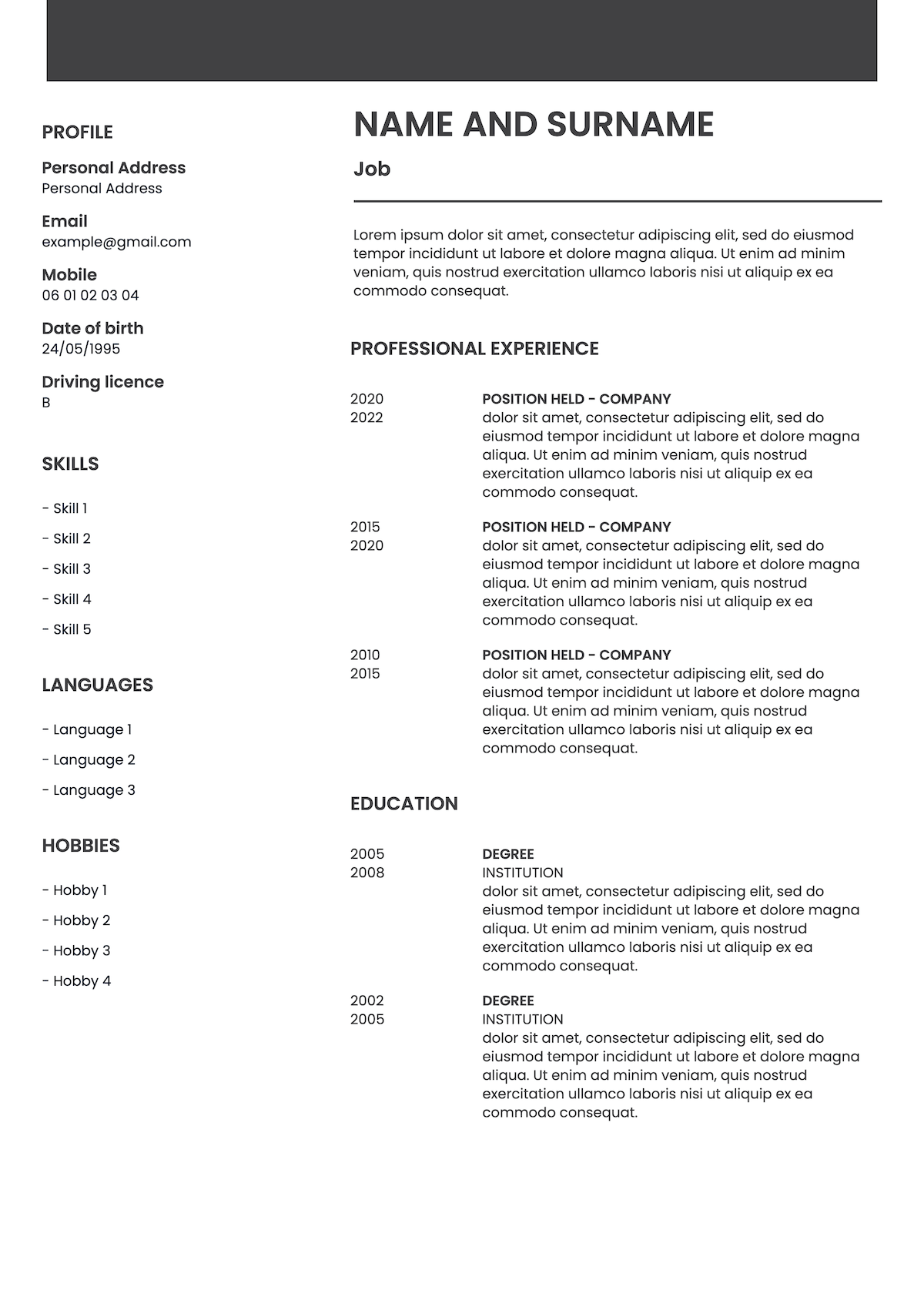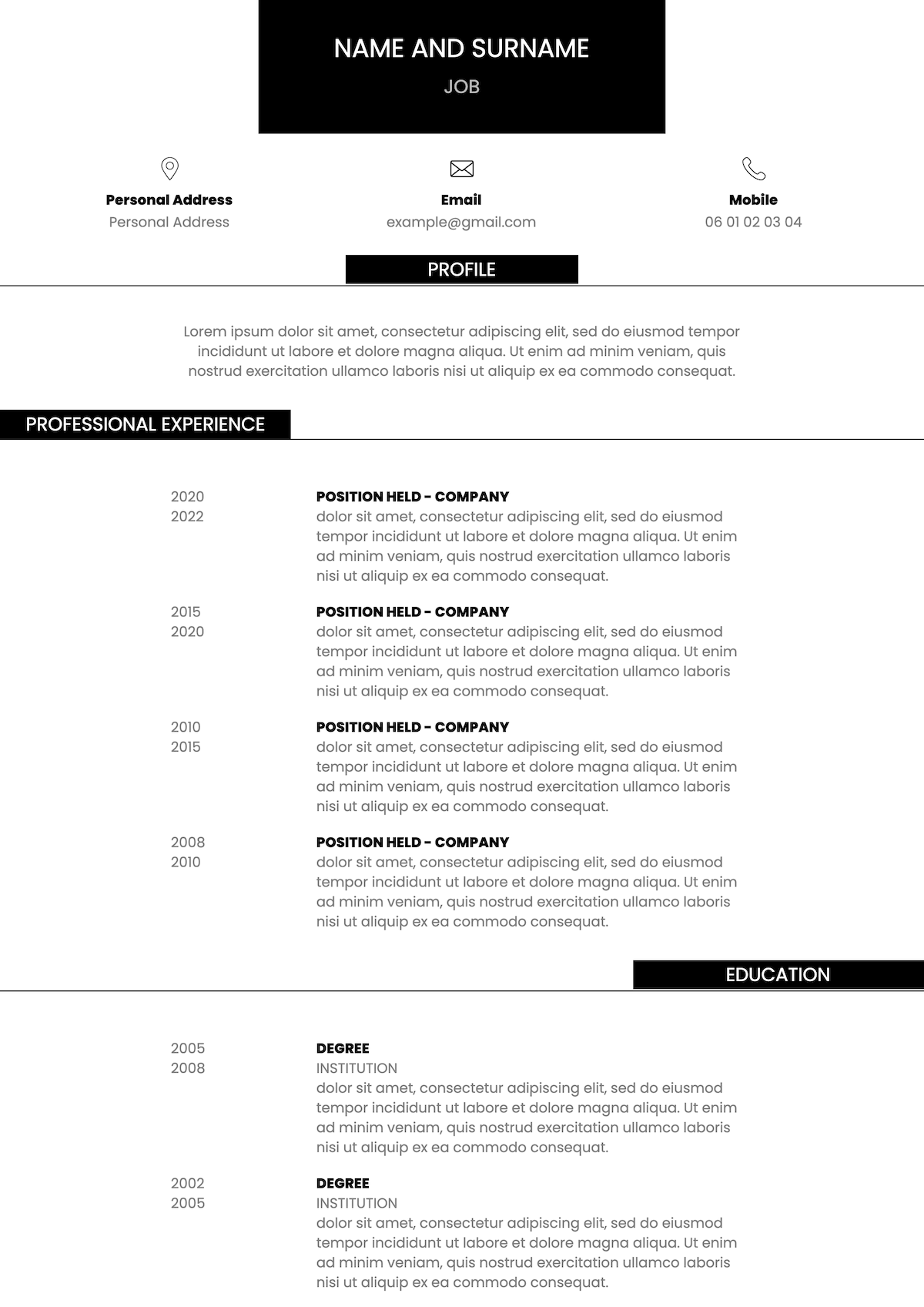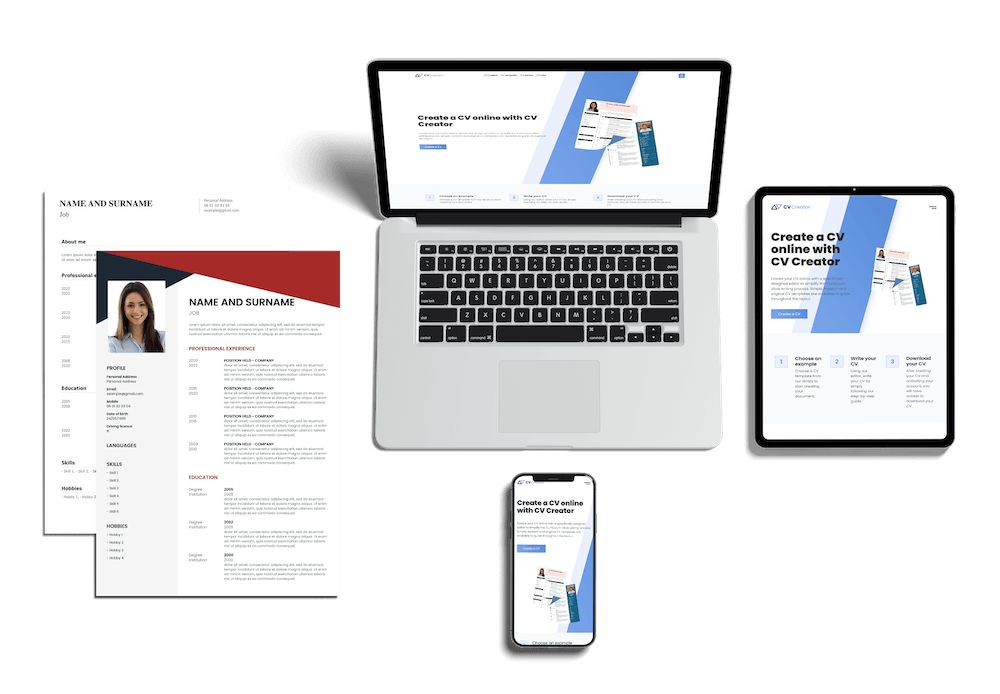Classic CV Template
At times, classic is the best way to go. For a simple, yet effective CV, the best one is by far the Classic CV. Follow this guide for expertly chosen Classic CV examples and tips that will land you a dream job.
Examples of classic CVs
Choose a Curriculum Vitae from our selection of classic examples
Classic CV template

A classic CV template is a timeless and versatile CV most suited for applicants applying in numerous industries.
Simple CV template

Example of simple CV to be completed online by an aspiring job hunter.
Classic and original CV

A contemporary yet classic and original CV template, with fonts and a design which will make your CV standout.
Classic CV without picture

This CV is suitable for applicants who are applying abroad, to countries which require no picture on an application form by law such as the UK or France.
Want to see more CV templates?

You might say, why choose a Classic CV? After all, we live in an age where technology is king. The idea of using a timeless CV as a template may seem like taking a step back. To choose a classic CV can seem uneasy. With access to many modern CV templates, a wealth of advice and ways to tailor your CV. But here is the main point. Can you be sure a modern CV will land you your dream job? Or will it be due to the tried and tested Classic CV to do the heavy lifting? To make things easier for you, I have compiled a list of reasons why you should choose this CV. So, let’s get the ball rolling! In a rush to build your CV? Don’t have time to go through the entire blog and need a great CV in 5 minutes? Give our CV Creator a go. With more than 20 tailored CV’s to choose from, you will be spoilt for choice. So if you are short of time, you can create your CV here.
Choose the Classic CV
Assume your CV is your own shop store image. You want to catch the mind of recruiters. Make them enter your shop and ask for more details. Therefore, it needs to present your contact details, profile, work experience and education. Do not forget to add your hobbies or skills at the end. It can be a life saver. However, not every shop window looks the same. Tailor the shop window to your credentials. This CV type follows a more traditional approach. It is better suited for certain companies. Review the guidelines of the Classic CV . This will make sure it meets your needs and shows your worth to recruiters. So let’s get going.
Introduce your Contact Details
Start your Classic CV by inputting your personal contact details. It allows hiring managers to contact you if you have caught their eye. Begin by writing your full name in the middle of the CV header. If not, use the extreme left or right of the CV header. Ensure you are using a larger font size to write your name. An ideal font size should be 14. Pick out a font that can easily be read by many people. Arial and Calibri are widely accepted fonts. Remember, you want to make sure people don’t forget your name. Add your professional email address and contact number. Depending on the type of vacancy, you may be required to provide a link to a digital portfolio or website. Research the company by contacting old employees. Ask what type of information they want to see on a CV. Here a few added tips for your Contact Details section:
- Do not include your Date of Birth. Since 2010, the Equality Act bans candidates from including this information unless necessary.
- Insert a spacing line between your contact details and personal statement. It provides more clarity and precision.
- Remove the words “Curriculum Vitae” from your CV. An employer knows what document he is looking at.
- Add a picture of yourself only if requested. Ensure it is a work picture.
- Use bold for all section main titles.
Write a Personal Summary
The Classic CV enables you to add a section before your work experience where you can explain your credentials. It gives you a chance to show why you are the right choice. Underline the keywords in the job description of your desired role. Make sure you have found between 5 and 7 CV keywords to use. Structure your personal summary around these keywords. Start your personal statement by providing details about your background. This can include prior professional work experience or volunteer work. Aim to match one of the keywords with your intro. It is vital to show the candidate understands what the employer needs. Do this by employing the same keywords and skills from the job advert in your personal statement. Finally, repeat this process for the other parts of the statement. An excellent statement should consist of prior work experience, achievements, skills and future ambitions and goals. Here is an example of a Classic CV Personal Statement: I am a qualified chartered surveyor. With more than 15 years of experience in surveying London properties for external and internal valuation purposes, I specialise in lease extensions and rent valuation reports. I have trained many junior surveyors to become Chartered and join the IRCS standard. I wish to focus expanding my surveying credentials and services. Currently pursuing opportunities that support my move into Property Asset Management as well as creating a Surveying Firm.
Insert your Work Experience
A classic CV follows a chronological CV structure. It means all your experience should be listed in reverse chronological order. Highlight your career achievements in this section. It is a chance to show the employer your abilities. It doesn’t mean you need to list all of them. As an example, you were a paperboy growing up. If you are applying to become a data analyst, there are few skills in this past experience that will be needed in data crunching. Here are few guidelines to follow when writing this section:
- Use active verbs to describe your work experience. As a rule, only employ words which can add rigor to your CV.
- Provide tangible results. Employers will rebuff candidates who put on their CV “helped increased sales” or “part of a team which helped reduce costs”. A recruiter wants numerical results alongside the progress made. Your CV should feature : helped reduce cost by 28% thanks to outsourcing of key supply chain.
- Start the section with most recent relevant work experience. Do not add roles that were held 10 years prior. If you evolved within a company, make it clear. Employers like candidates go up the ranks.
- Employ job advert keywords throughout your work experience descriptions. It will show the employer you are capable of transferring skills from prior jobs to the current one.
Here is an example of work experience for a Classic CV:
- Portfolio Manager, Architas, London. 2013-2018.
- Managed £800 million in AUM. Inflows increased by 46% over 5 years. Achieved a 10% CAGR return over my tenure. Introduced new instruments and products to International Clients. Raised profile of the company by launching new Family Offices in Singapore and Luxembourg.
Add your Academic Achievements
Ensure you list your academic achievements. If you are a graduate, this section carries as much wright as the work experience. A classic CV template gives a great chance for candidates to prove their academic results. Here is a simple guide to follow when listing your education:
- Begin with the highest level of education you have received. This can include a Ph.D, a Master’s Degree or Bachelor’s Degree. It is often unnecessary to list GCSE results when you have completed studies after leaving college.
- Include your end of year thesis, important seminars or modules. Showcase how skills learnt in the classroom can be transferred into the office.
- Add ongoing certifications or qualifications. For example, the CFA tests have 3 levels and take 4 years to complete.
Create a Skills Section
A Classic CV should include a specialised skills segment to showcase your transferable skills. Keep in mind, just like your work experience, tailor the skills for the job advert. Facilitate the task for an employer. If they see the keywords appear in your skills, they will show interest. It means certain of your skills will not feature on this CV. That’s okay. The aim is to land your dream job, not make an endless list of skills. Follow these simple steps to ensure you come out on top:
- Focus on hard skills. They are tangible and easy to explain. Managers can relate. Languages are also a great add in this segment. Add your level of proficiency using the CEFR assessment.
- Explain how you have developed your skills. It will show that you understand the skills you have and how they can be used in the firm.
- Develop the technical aspects of your skills. Proficiency in any skill, however menial, is a plus.
Include Hobbies and Interests
Adding a hobbies section to your CV is not a must. It’s an extra section that can make a big difference. In addition, for a Classic CV template, it adds great value. Hobbies are a reflection of our personalities. You can show interests and skills that could not be placed elsewhere on your CV. It’s also a great moment to include volunteer work, personal achievements and projects. If you have hobbies and interests you would like to add, follow these simple rules for your CV:
- Add skills unrelated to your workplace skills. As an example, video editing short movies or making ice cream desserts.
- Show your social media savviness. Companies always need streetwise individuals. Especially for social media needs.
- Consider sports and languages for your CV. To play a sport is a great way to impress employers. Whether it is a team or individual sport, many great qualities can be developed. Mastering languages is equally well rewarded. Just add your proficiency in another language can be a big boost.
- Highlight any rewards or key roles you have in clubs, associations. It shows just as much passion as it does leadership. Skills needed in droves by recruiters.
Key Points to Takeaway for a Classic CV
Here are the key points for you to take away for a Classic CV. These will make sure you are successful in your applications :
- Use this CV type if you are following a direct career trajectory. Make sure you follow the structure in the right way.
- Focus on keywords. By keeping your attention on the keywords of a job advert, you will be able to tailor your CV with ease. An employer appreciates a CV which has been customised for a specific role.
- Be proactive. Don’t wait for the phone to ring. Develop skills by volunteering or taking a professional course.
Still have questions unanswered on how to explain gaps in your CV? Not sure how to explain the gaps you have properly? Then please get in touch here. We would love to help you reach your dream career.

